Swiss vs Taiwanese Community Comparison
COMPARE
Swiss
Taiwanese
Social Comparison
Social Comparison
Swiss
Taiwanese
7,517
SOCIAL INDEX
72.7/ 100
SOCIAL RATING
114th/ 347
SOCIAL RANK
6,532
SOCIAL INDEX
62.8/ 100
SOCIAL RATING
151st/ 347
SOCIAL RANK
Taiwanese Integration in Swiss Communities
The statistical analysis conducted on geographies consisting of 31,374,160 people shows a perfect positive correlation between the proportion of Taiwanese within Swiss communities in the United States with a correlation coefficient (R) of 0.999. On average, for every 1% (one percent) increase in Swiss within a typical geography, there is an increase of 0.029% in Taiwanese. To illustrate, in a geography comprising of 100,000 individuals, a rise of 1,000 Swiss corresponds to an increase of 29.0 Taiwanese.
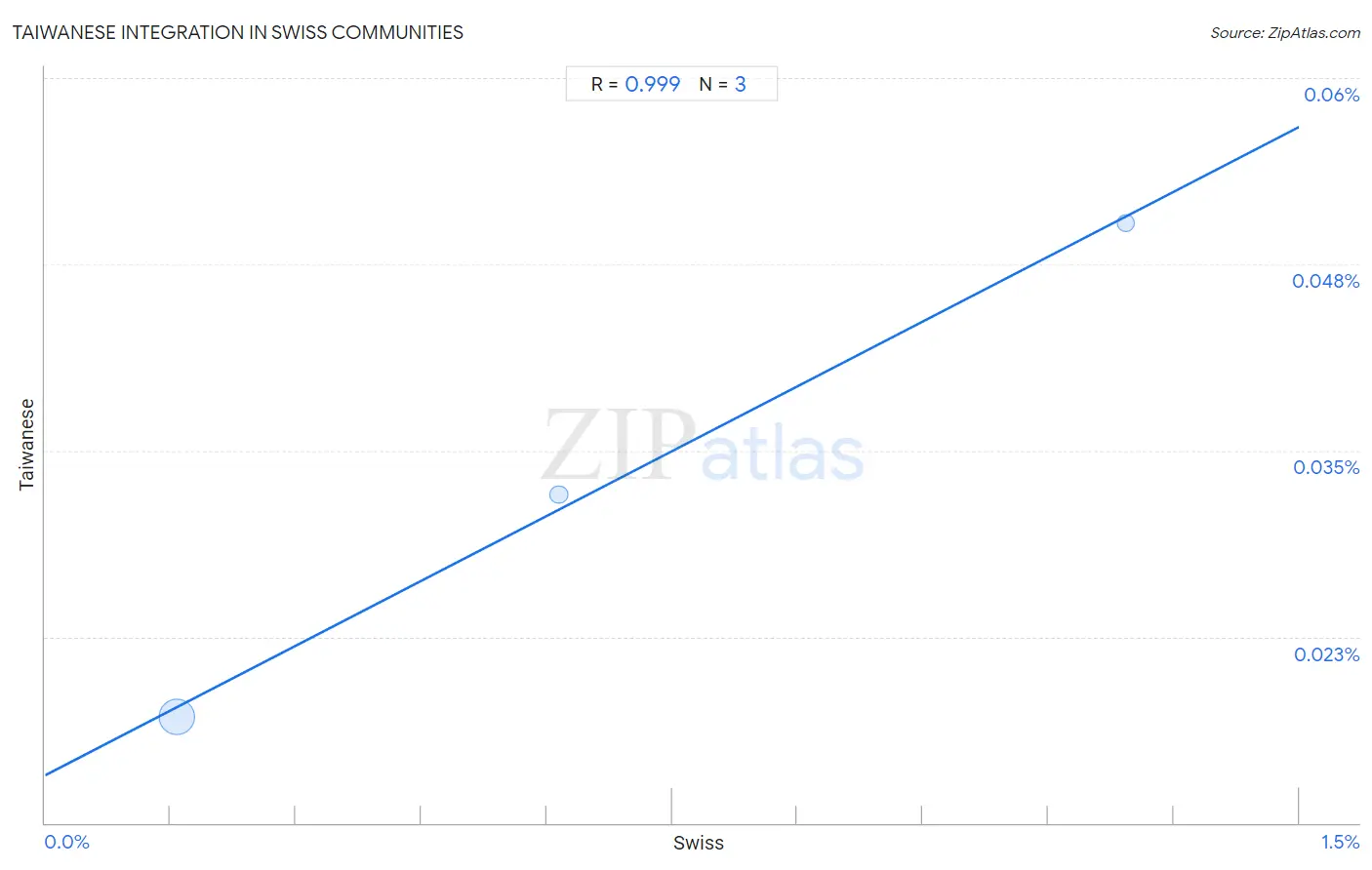
Swiss vs Taiwanese Income
When considering income, the most significant differences between Swiss and Taiwanese communities in the United States are seen in wage/income gap (30.0% compared to 25.1%, a difference of 19.2%), median female earnings ($37,904 compared to $40,576, a difference of 7.0%), and householder income ages 25 - 44 years ($95,511 compared to $101,492, a difference of 6.3%). Conversely, both communities are more comparable in terms of median male earnings ($55,731 compared to $55,556, a difference of 0.32%), householder income ages 45 - 64 years ($103,071 compared to $104,180, a difference of 1.1%), and householder income over 65 years ($61,621 compared to $62,894, a difference of 2.1%).

| Income Metric | Swiss | Taiwanese |
| Per Capita Income | Good $44,076 | Exceptional $46,455 |
| Median Family Income | Good $104,396 | Exceptional $107,295 |
| Median Household Income | Average $85,681 | Exceptional $89,900 |
| Median Earnings | Average $46,315 | Excellent $47,902 |
| Median Male Earnings | Good $55,731 | Good $55,556 |
| Median Female Earnings | Tragic $37,904 | Excellent $40,576 |
| Householder Age | Under 25 years | Poor $51,493 | Tragic $49,804 |
| Householder Age | 25 - 44 years | Good $95,511 | Exceptional $101,492 |
| Householder Age | 45 - 64 years | Good $103,071 | Excellent $104,180 |
| Householder Age | Over 65 years | Good $61,621 | Excellent $62,894 |
| Wage/Income Gap | Tragic 30.0% | Excellent 25.1% |
Swiss vs Taiwanese Poverty
When considering poverty, the most significant differences between Swiss and Taiwanese communities in the United States are seen in single male poverty (13.8% compared to 10.9%, a difference of 26.5%), seniors poverty over the age of 65 (9.2% compared to 11.2%, a difference of 21.1%), and single father poverty (17.3% compared to 14.3%, a difference of 20.5%). Conversely, both communities are more comparable in terms of child poverty among boys under 16 (14.8% compared to 14.8%, a difference of 0.040%), child poverty under the age of 16 (14.5% compared to 14.5%, a difference of 0.29%), and child poverty among girls under 16 (14.8% compared to 14.6%, a difference of 1.1%).
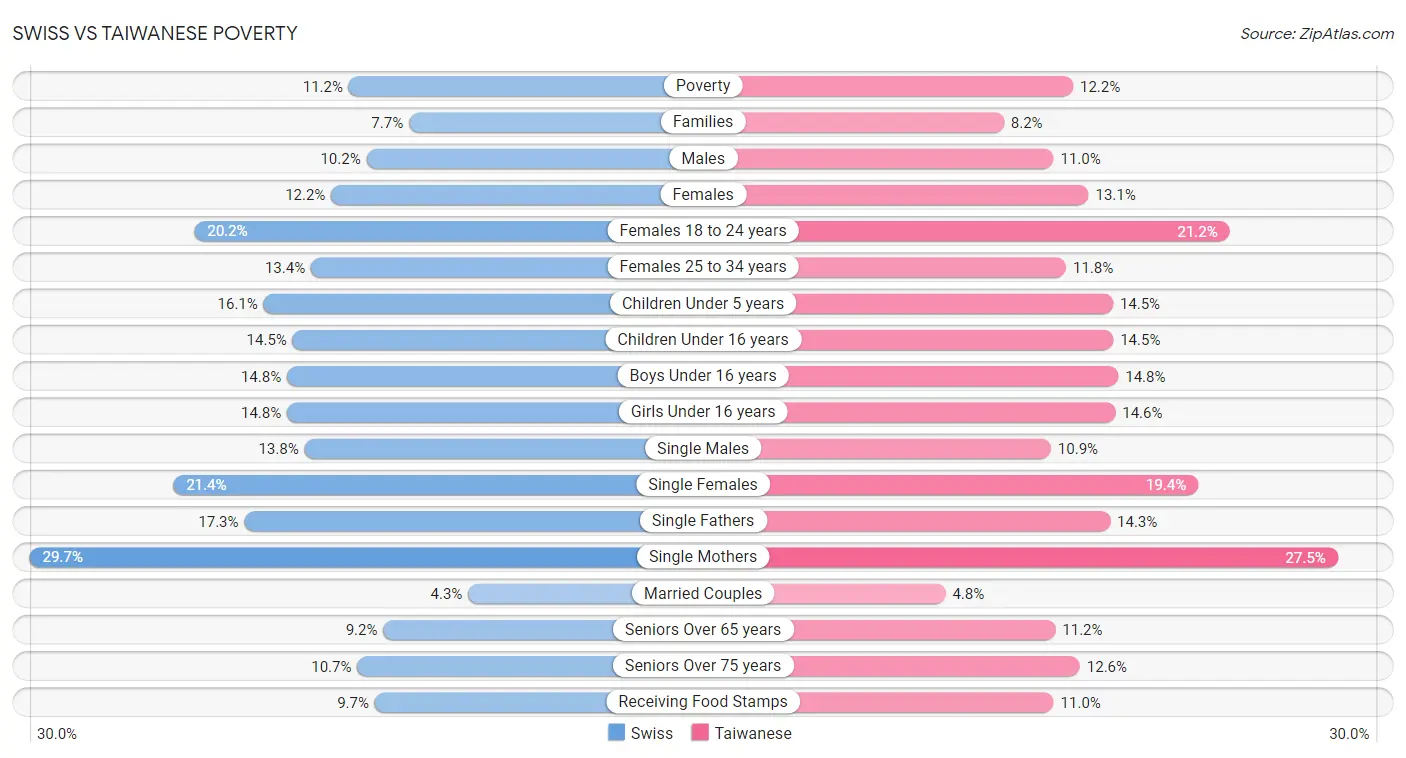
| Poverty Metric | Swiss | Taiwanese |
| Poverty | Exceptional 11.2% | Good 12.2% |
| Families | Exceptional 7.7% | Exceptional 8.2% |
| Males | Exceptional 10.2% | Good 11.0% |
| Females | Exceptional 12.2% | Good 13.1% |
| Females 18 to 24 years | Average 20.2% | Tragic 21.2% |
| Females 25 to 34 years | Good 13.4% | Exceptional 11.8% |
| Children Under 5 years | Exceptional 16.1% | Exceptional 14.5% |
| Children Under 16 years | Exceptional 14.5% | Exceptional 14.5% |
| Boys Under 16 years | Exceptional 14.8% | Exceptional 14.8% |
| Girls Under 16 years | Exceptional 14.8% | Exceptional 14.6% |
| Single Males | Tragic 13.8% | Exceptional 10.9% |
| Single Females | Fair 21.4% | Exceptional 19.4% |
| Single Fathers | Tragic 17.3% | Exceptional 14.3% |
| Single Mothers | Poor 29.7% | Exceptional 27.5% |
| Married Couples | Exceptional 4.3% | Exceptional 4.8% |
| Seniors Over 65 years | Exceptional 9.2% | Fair 11.2% |
| Seniors Over 75 years | Exceptional 10.7% | Poor 12.6% |
| Receiving Food Stamps | Exceptional 9.7% | Excellent 11.0% |
Swiss vs Taiwanese Unemployment
When considering unemployment, the most significant differences between Swiss and Taiwanese communities in the United States are seen in unemployment among seniors over 75 years (9.5% compared to 6.6%, a difference of 45.2%), unemployment among women with children ages 6 to 17 years (9.0% compared to 6.5%, a difference of 39.9%), and unemployment among women with children under 6 years (7.9% compared to 6.1%, a difference of 29.9%). Conversely, both communities are more comparable in terms of unemployment among ages 30 to 34 years (5.3% compared to 5.3%, a difference of 0.82%), unemployment among ages 35 to 44 years (4.4% compared to 4.4%, a difference of 0.93%), and unemployment among ages 16 to 19 years (15.8% compared to 15.5%, a difference of 1.5%).
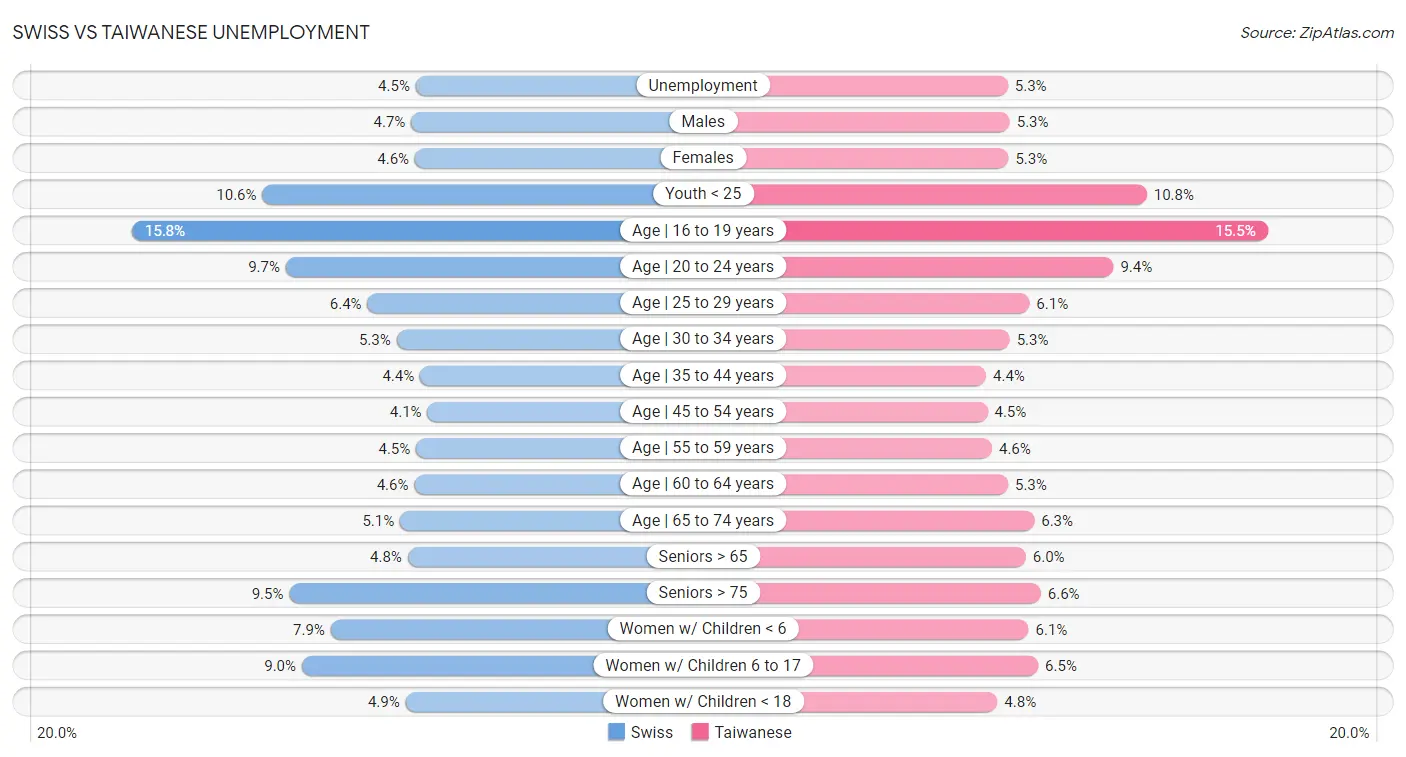
| Unemployment Metric | Swiss | Taiwanese |
| Unemployment | Exceptional 4.5% | Average 5.3% |
| Males | Exceptional 4.7% | Fair 5.3% |
| Females | Exceptional 4.6% | Average 5.3% |
| Youth < 25 | Exceptional 10.6% | Exceptional 10.8% |
| Age | 16 to 19 years | Exceptional 15.8% | Exceptional 15.5% |
| Age | 20 to 24 years | Exceptional 9.7% | Exceptional 9.4% |
| Age | 25 to 29 years | Excellent 6.4% | Exceptional 6.1% |
| Age | 30 to 34 years | Excellent 5.3% | Good 5.3% |
| Age | 35 to 44 years | Exceptional 4.4% | Exceptional 4.4% |
| Age | 45 to 54 years | Exceptional 4.1% | Good 4.5% |
| Age | 55 to 59 years | Exceptional 4.5% | Exceptional 4.6% |
| Age | 60 to 64 years | Exceptional 4.6% | Tragic 5.3% |
| Age | 65 to 74 years | Exceptional 5.1% | Tragic 6.3% |
| Seniors > 65 | Exceptional 4.8% | Tragic 6.0% |
| Seniors > 75 | Tragic 9.5% | Exceptional 6.6% |
| Women w/ Children < 6 | Poor 7.9% | Exceptional 6.1% |
| Women w/ Children 6 to 17 | Fair 9.0% | Exceptional 6.5% |
| Women w/ Children < 18 | Exceptional 4.9% | Exceptional 4.8% |
Swiss vs Taiwanese Labor Participation
When considering labor participation, the most significant differences between Swiss and Taiwanese communities in the United States are seen in in labor force | age 16-19 (43.3% compared to 33.8%, a difference of 27.9%), in labor force | age 20-24 (77.7% compared to 74.7%, a difference of 4.0%), and in labor force | age > 16 (64.4% compared to 66.2%, a difference of 2.7%). Conversely, both communities are more comparable in terms of in labor force | age 30-34 (84.3% compared to 84.6%, a difference of 0.34%), in labor force | age 45-54 (82.8% compared to 83.4%, a difference of 0.75%), and in labor force | age 25-29 (84.7% compared to 85.4%, a difference of 0.83%).

| Labor Participation Metric | Swiss | Taiwanese |
| In Labor Force | Age > 16 | Tragic 64.4% | Exceptional 66.2% |
| In Labor Force | Age 20-64 | Fair 79.4% | Exceptional 80.2% |
| In Labor Force | Age 16-19 | Exceptional 43.3% | Tragic 33.8% |
| In Labor Force | Age 20-24 | Exceptional 77.7% | Fair 74.7% |
| In Labor Force | Age 25-29 | Good 84.7% | Exceptional 85.4% |
| In Labor Force | Age 30-34 | Tragic 84.3% | Fair 84.6% |
| In Labor Force | Age 35-44 | Poor 84.2% | Exceptional 85.1% |
| In Labor Force | Age 45-54 | Average 82.8% | Exceptional 83.4% |
Swiss vs Taiwanese Family Structure
When considering family structure, the most significant differences between Swiss and Taiwanese communities in the United States are seen in married-couple households (49.9% compared to 45.9%, a difference of 8.8%), currently married (49.7% compared to 45.8%, a difference of 8.6%), and births to unmarried women (30.5% compared to 29.0%, a difference of 5.2%). Conversely, both communities are more comparable in terms of single mother households (5.6% compared to 5.8%, a difference of 2.3%), average family size (3.15 compared to 3.23, a difference of 2.5%), and family households (65.2% compared to 63.3%, a difference of 3.0%).

| Family Structure Metric | Swiss | Taiwanese |
| Family Households | Exceptional 65.2% | Tragic 63.3% |
| Family Households with Children | Excellent 27.7% | Tragic 26.7% |
| Married-couple Households | Exceptional 49.9% | Fair 45.9% |
| Average Family Size | Tragic 3.15 | Average 3.23 |
| Single Father Households | Good 2.3% | Exceptional 2.2% |
| Single Mother Households | Exceptional 5.6% | Exceptional 5.8% |
| Currently Married | Exceptional 49.7% | Poor 45.8% |
| Divorced or Separated | Good 12.0% | Exceptional 11.5% |
| Births to Unmarried Women | Excellent 30.5% | Exceptional 29.0% |
Swiss vs Taiwanese Vehicle Availability
When considering vehicle availability, the most significant differences between Swiss and Taiwanese communities in the United States are seen in no vehicles in household (7.9% compared to 11.7%, a difference of 48.4%), 3 or more vehicles in household (23.0% compared to 20.0%, a difference of 14.9%), and 2 or more vehicles in household (61.0% compared to 53.9%, a difference of 13.2%). Conversely, both communities are more comparable in terms of 1 or more vehicles in household (92.3% compared to 88.4%, a difference of 4.4%), 4 or more vehicles in household (7.8% compared to 7.0%, a difference of 10.5%), and 2 or more vehicles in household (61.0% compared to 53.9%, a difference of 13.2%).

| Vehicle Availability Metric | Swiss | Taiwanese |
| No Vehicles Available | Exceptional 7.9% | Tragic 11.7% |
| 1+ Vehicles Available | Exceptional 92.3% | Tragic 88.4% |
| 2+ Vehicles Available | Exceptional 61.0% | Tragic 53.9% |
| 3+ Vehicles Available | Exceptional 23.0% | Excellent 20.0% |
| 4+ Vehicles Available | Exceptional 7.8% | Exceptional 7.0% |
Swiss vs Taiwanese Education Level
When considering education level, the most significant differences between Swiss and Taiwanese communities in the United States are seen in no schooling completed (1.5% compared to 2.5%, a difference of 63.1%), professional degree (4.5% compared to 5.0%, a difference of 11.2%), and master's degree (14.7% compared to 16.1%, a difference of 9.0%). Conversely, both communities are more comparable in terms of nursery school (98.6% compared to 97.6%, a difference of 1.0%), kindergarten (98.5% compared to 97.5%, a difference of 1.0%), and 1st grade (98.5% compared to 97.5%, a difference of 1.0%).
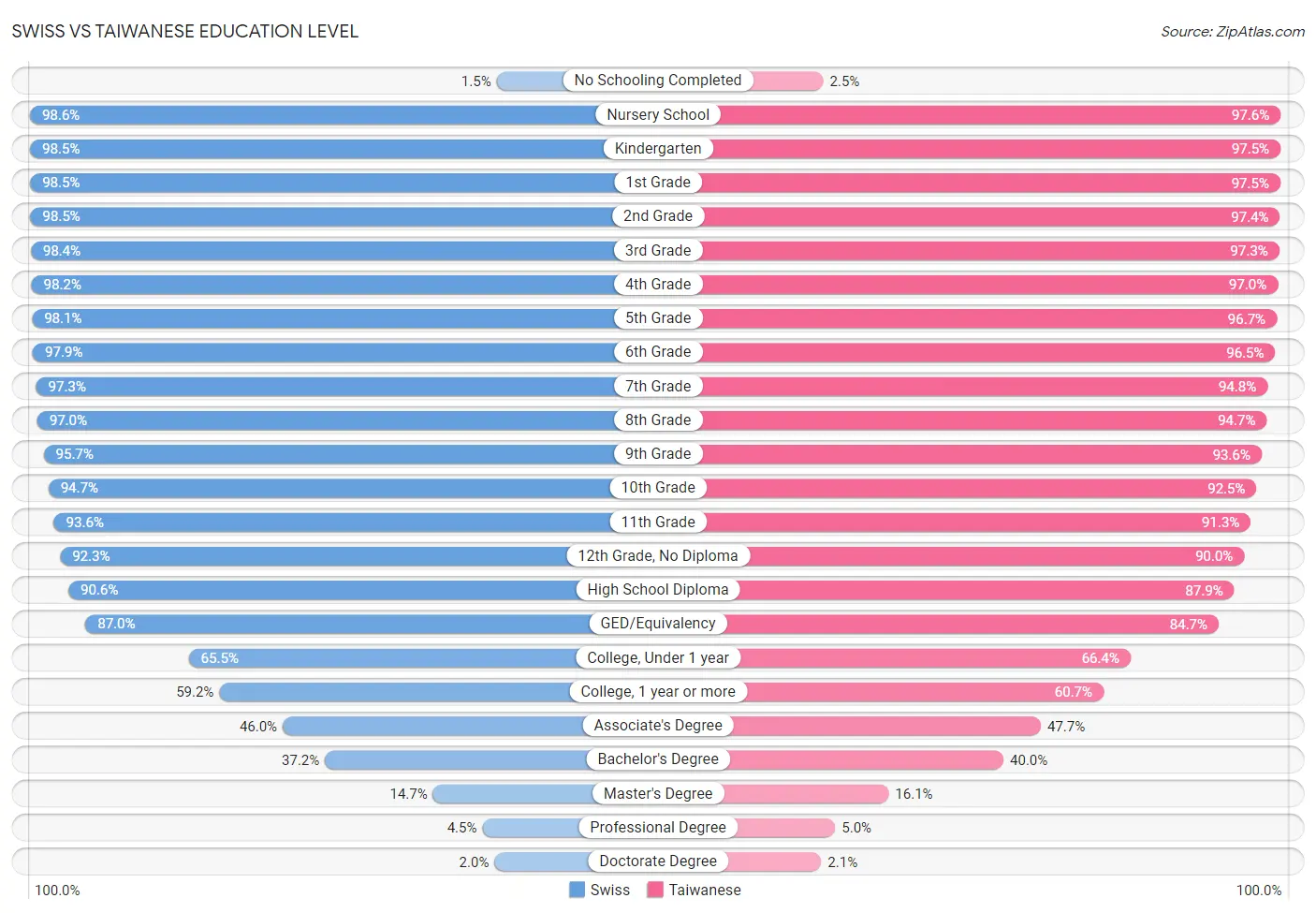
| Education Level Metric | Swiss | Taiwanese |
| No Schooling Completed | Exceptional 1.5% | Tragic 2.5% |
| Nursery School | Exceptional 98.6% | Tragic 97.6% |
| Kindergarten | Exceptional 98.5% | Tragic 97.5% |
| 1st Grade | Exceptional 98.5% | Tragic 97.5% |
| 2nd Grade | Exceptional 98.5% | Tragic 97.4% |
| 3rd Grade | Exceptional 98.4% | Tragic 97.3% |
| 4th Grade | Exceptional 98.2% | Tragic 97.0% |
| 5th Grade | Exceptional 98.1% | Tragic 96.7% |
| 6th Grade | Exceptional 97.9% | Tragic 96.5% |
| 7th Grade | Exceptional 97.3% | Tragic 94.8% |
| 8th Grade | Exceptional 97.0% | Tragic 94.7% |
| 9th Grade | Exceptional 95.7% | Tragic 93.6% |
| 10th Grade | Exceptional 94.7% | Tragic 92.5% |
| 11th Grade | Exceptional 93.6% | Tragic 91.3% |
| 12th Grade, No Diploma | Exceptional 92.3% | Tragic 90.0% |
| High School Diploma | Exceptional 90.6% | Tragic 87.9% |
| GED/Equivalency | Exceptional 87.0% | Tragic 84.7% |
| College, Under 1 year | Average 65.5% | Good 66.4% |
| College, 1 year or more | Average 59.2% | Excellent 60.7% |
| Associate's Degree | Average 46.0% | Excellent 47.7% |
| Bachelor's Degree | Fair 37.2% | Exceptional 40.0% |
| Master's Degree | Average 14.7% | Exceptional 16.1% |
| Professional Degree | Good 4.5% | Exceptional 5.0% |
| Doctorate Degree | Excellent 2.0% | Exceptional 2.1% |
Swiss vs Taiwanese Disability
When considering disability, the most significant differences between Swiss and Taiwanese communities in the United States are seen in hearing disability (3.5% compared to 2.8%, a difference of 27.0%), disability age under 5 (1.6% compared to 1.3%, a difference of 24.0%), and disability age 18 to 34 (7.4% compared to 6.0%, a difference of 23.5%). Conversely, both communities are more comparable in terms of disability age 65 to 74 (22.9% compared to 22.7%, a difference of 0.89%), self-care disability (2.4% compared to 2.4%, a difference of 1.0%), and disability age over 75 (46.2% compared to 48.2%, a difference of 4.3%).
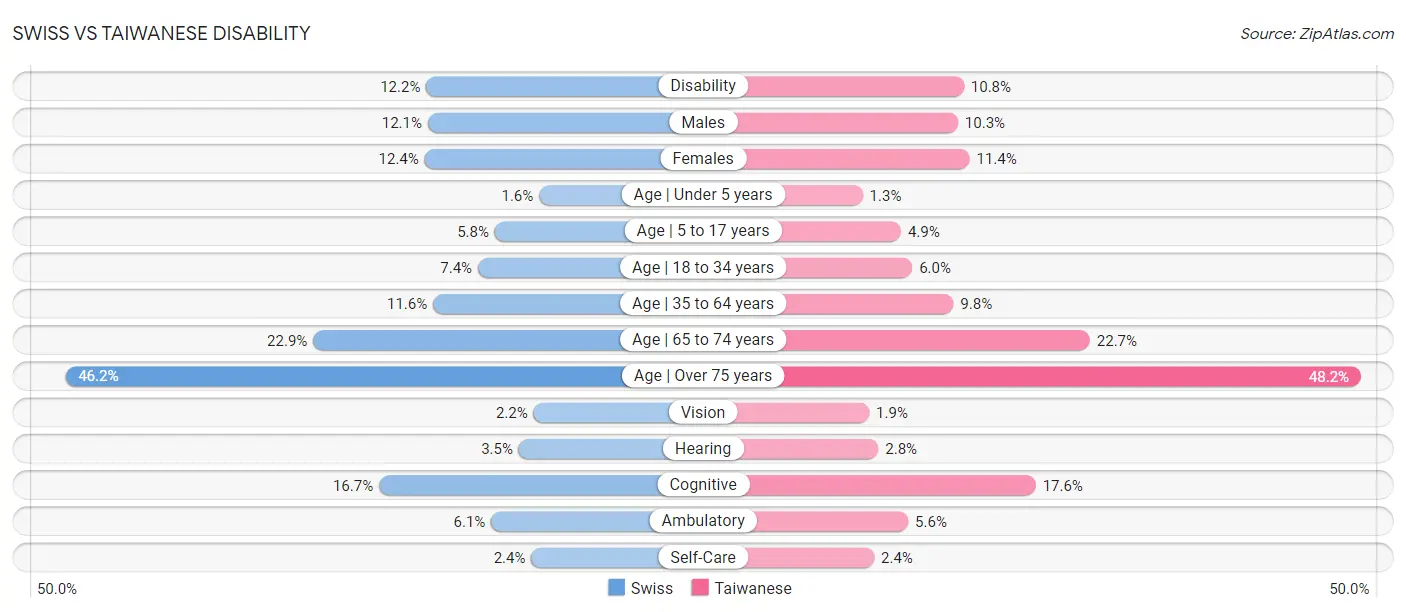
| Disability Metric | Swiss | Taiwanese |
| Disability | Tragic 12.2% | Exceptional 10.8% |
| Males | Tragic 12.1% | Exceptional 10.3% |
| Females | Poor 12.4% | Exceptional 11.4% |
| Age | Under 5 years | Tragic 1.6% | Tragic 1.3% |
| Age | 5 to 17 years | Tragic 5.8% | Exceptional 4.9% |
| Age | 18 to 34 years | Tragic 7.4% | Exceptional 6.0% |
| Age | 35 to 64 years | Poor 11.6% | Exceptional 9.8% |
| Age | 65 to 74 years | Good 22.9% | Excellent 22.7% |
| Age | Over 75 years | Exceptional 46.2% | Tragic 48.2% |
| Vision | Average 2.2% | Exceptional 1.9% |
| Hearing | Tragic 3.5% | Exceptional 2.8% |
| Cognitive | Exceptional 16.7% | Tragic 17.6% |
| Ambulatory | Average 6.1% | Exceptional 5.6% |
| Self-Care | Exceptional 2.4% | Exceptional 2.4% |